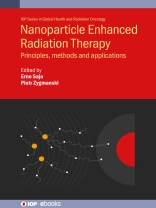Improved targeting of abnormal cells and tissue in the radiotherapy of cancer has been a long-standing goal of researchers. The central purpose of nanoparticle-enhanced radiotherapy (NPRT) is to more precisely control where the radiation dose is delivered, desirably with subcellular precision, provided we can find a method to bring the nanoparticles to target as well as control their concentration and size distribution.
The contents within this book will cover the rationale and fundamental principles of NPRT, optimal nanoparticle sizes, concentrations, design and fabrication, effective nanoparticle delivery methods, emerging clinical applications of NRT modalities, treatment planning and quality assurance and the potential of NPRT in global health. This volume will serve as a resource for researchers, educators and industry, and as a practical guide or comprehensive reference for students, research trainees and others working in cancer nanomedicine.
Key Features
- Covers the most important advances in nanoparticle-aided radiation therapy over the last few decades
- Features contributions from leaders in the field
- Focuses first on the fundamentals of radiosensitization, then it continues with imaging methods and concludes with various clinical applications
Cuprins
Introduction
Part I Radiosensitization and fundamentals
1 The role of Auger electrons versus photoelectrons in nanoparticle dose enhancement
2 Deterministic computation benchmarks of nanoparticle dose enhancement—part I. Nanometer scales
3 Deterministic computation benchmarks of nanoparticle dose enhancement—part II. Microscopic to macroscopic scales
4 Mechanisms of low energy electron interactions with biomolecules: relationship to gold nanoparticle radiosensitization
5 Monte Carlo models of electron transport for dose-enhancement calculations in nanoparticle-aided radiotherapy
6 Nanoparticle-aided radiation therapy: challenges of treatment planning
7 Nanoparticle aided radiotherapy: quality assurance perspective
8 Optimal nanoparticle concentrations, toxicity and safety and gold nanoparticle design for radiation therapy applications
9 Translational nanomaterials for cancer radiation therapy
10 Gold nanoparticle enhanced radiosensitivity of cells: considerations and contradictions from model systems and basic investigations of cell damaging for radiation therapy
Part II Imaging
11 Super-resolution microscopy of nanogold-labelling
12 X-ray based nanoparticle imaging
13 MRI based nanoparticle imaging
14 Nanoparticle detection using photoacoustic imaging (PAI)
Part III Applications
15 Radiotherapy application with in situ dose-painting (RAi D) via inhalation delivery
16 High-Z ORAYA therapy for wet AMD and ocular cancers
17 Cerium oxide and titanium dioxide
18 Accelerated Partial Breast Irradiation (APBI)
Despre autor
Erno Sajo is a Professor and the Director of medical physics at the University of Massachusetts Lowell, where he also serves as the Director of biomedical engineering and biotechnology. His research areas are radiation transport computations at the nanoscale with emphasis on interfacial effects, including nanoparticle transport, the physiological translocation of nanoparticles, and nanoparticle enhanced radiation therapy. He is an Associate Editor of the Health Physics journal and has also served as an ad-hoc Editor of Medical Physics. Piotr Zygmanski is an Associate Professor of radiation oncology at the Harvard Medical School and a medical physicist at the Brigham and Women’s Hospital/Dana Farber Cancer Institute, Boston, Massachusetts. Prior to his present position he acquired his clinical training at the Massachusetts General Hospital, and the Harvard Cyclotron Laboratory. His research interests include multiscale radiation transport computations, detection of radiation and mathematical modeling for standard and nanoparticle enhanced radiotherapy.












